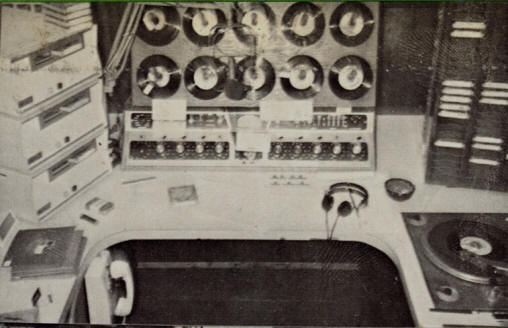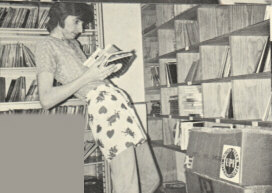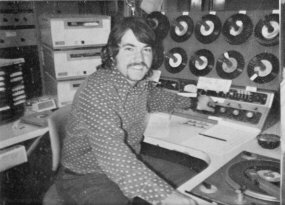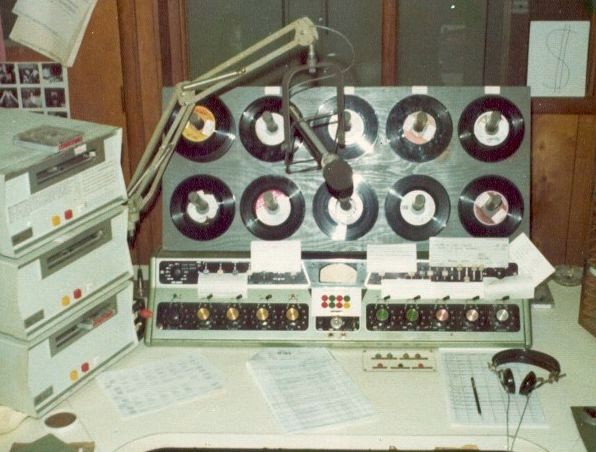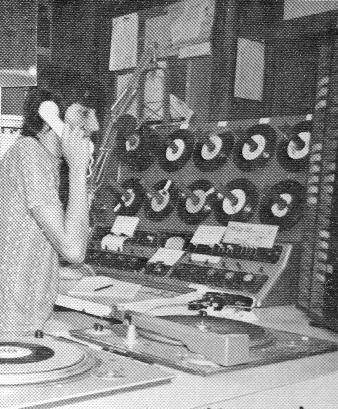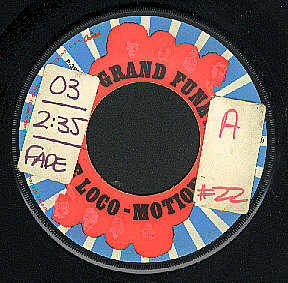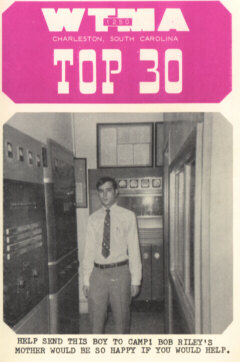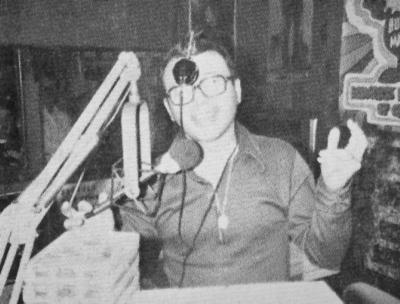|
Home | DJs | Pictures | Audio | Features | Messages | WCSC | WKTM | WOKE | Contact |
|
Additional Info from Kirk Varner After seeing the photos of WTMA's Control Room in the early 70s, we asked former WTMA DJ John Burwell how everything was laid out. Q: Did WTMA have remote starts for the turntables and cart decks?
JB:
Oh yes. Look to the above left of the headphones. That's the button panel.
Top row, from left to right: Front Turntable Start & Stop and Back
Turntable Start & Stop. On the second row there are buttons to start the
Top Cart, the Middle Cart, and the Bottom Cart.
Once a week, Kirk Varner
would re-file all the oldies we used in the previous week. That's what you
see him doing in that picture of him wearing the boxers on the outside of
his pants. JB:
In 1976, WTMA engineer Charlie McHan carted all our oldies, because
some were getting too cue-burned to use, and back then "oldies" weren't
being sold in stores or on the Internet. Charlie bought a cart winder and
cart parts, and I wound all the carts - about 300 of them. He recorded
them.
Q: Do you remember when
you got the two ITC triple deckers in the control room to replace the
three standalone cart decks? JB: Looking at the Gatesway console's bottom row of knobs, from left to right, I'll number them this way: 1-5, (now we're in the center where the VU was) and then 6-10 (10 is on the far right).
Former WTMA DJ Kirk Varner adds more details about WTMA's control room and on-air operations. I loved the WTMA Control Room
Q & A with John Burwell, and thought you might be interested in
some more details as I recall them: John Burwell comments: I had forgotten all about the automatic features of the Jock-o-Matic, because during the day we never EVER used it like he described. We would let it fire off the commercials, but coming out of the last spot was all me, every time. For the day jocks, the shotgun went in rotation with the rest of the spots in the three stack. (For you jingle fans, the TMA shotgun jingle was an edited-down fast tempo cut from the TM "Phase II" jingle package. PD J.J. Scott spent hours editing it down from the original track that contained the extra three note sting after the call letters that led into the singers delivering acapella logos like "Golden" or "Hitbound" -- because there was no mix-out on the master reel without the end sting!)
There was one more remote
switch on the console that bears mentioning. It is hard to see here, it
was underneath the center white index card clipped below the VU meter. It
was a red button that engaged the infamous "accent reverb". You pushed it
to sound really dramatic, usually at the top of the hour time check
rolling out of the top-of-the-hour Stager/Legal ID.
In the studio photo with me
on the air, you can see a few more cards on the console. These were
additional liners or things that we were supposed to push during each
hour. The light-switch looking "keys" over the pots at the right end of
the board (numbers 9 & 10) that held up the weather card were used to
select a few additional remote inputs to the board, which included the
Mutual radio network feed. While 'TMA didn't usually run Mutual's top of
hour newscasts, I believe we did a few newscasts on the overnight shift
from time to time and we usually ran spots from the Mutual network in the
off-hours.
Moving to the left, one peg at a time were "B" records, basically the 10-20 records from the top 30 playlist. Then to the left were the "C" records, the final ten or so from 20 to 30 on the list. Next up was the "D" peg which were the hitbounds, which got the slowest rotation of one per hour. (We really did focus on playing the hits.) The last peg on the left was the "recurrents", a larger stack of those songs that had just moved off the chart, but weren't yet in the oldies library. The oldies were kept in separate green cardboard "sleeves" to try to keep them playable as they made their way from the music library off the PD's office, to and from the air studio. You can see those in the stack on the left, over the wall mount-style phone that was mounted just under the desktop on at the jock's left knee.
Records got two white rectangular stickers, positioned at the "3 o'clock" and "9 o'clock" positions on their center labels. One label featured the records current letter status "A, B, C...", which would be changed to the year of the record when it went into the "golden" category. Another label contained the ramp-up time to the vocal post in seconds, with the total record time below that, and then whether the record ended cold or faded out. We also put white labels on the "B" side of the 45s to prevent a jock working quickly from throwing the wrong side of the 45 on the turntable. You can see one of those clearly on the record on the lower peg on the far left side. When "B" sides got a little more interesting, musically speaking, some overnight and weekend jocks (whose names shall go unmentioned here to protect the innocent) would pull off these white labels and try to get a little adventurous with the playlist. At some point, frustrated PD's began actually "scratching" the B sides to make them completely unplayable. As John mentions, you couldn't play two female or black artists back-to-back in the format, and that was the only time you could play a record out of rotation from the pegs to prevent violating those cardinal rules of the format. Click here to see more about WTMA's Music Rotation and Record Labeling The turntables at TMA were these gigantic RCA studio models that were unique for a couple of reasons. They had permanent impressions and spindles (the part in the middle that went in the hole at the center of the record) for 45s, but you could also play the bigger 12-inch "LP-style" albums as well. The only albums that were played in this era were the weekly discs that Casey Kasem's "American Top 40" arrived on from Watermark productions each week. (Remember this was long before CDs had been invented or satellite delivery became common for this kind of thing.) John mentions that the discs that became "oldies" were victims of "cue burn" from their use on these turntables. The tone arms, as you can see, were massive and tracked the discs very heavy. In fact there was a note admonishing us to cue up records only once each time we played them. John
Burwell comments: Under Charlie's command we ran
state-of-the art Stantons tracking at 3/4 gram in those tone arms. Cue
burn was cause by poor vinyl, not our tone arms. Capitol and RCA would
last forever. Motown, Buddah, Arista and especially Bell wore out quickly.
You could get about 2 days out of a Bell before cue burn. Columbia always
had small scratches and pops, straight out of the sleeve.
You can't see in these photos, but there was a big window that was visible above the records on the peg board. It looked out onto to the big 5KW transmitter that put out WTMA's primary daytime signal. (Above you can see an early version of this setup on the front of the Top 30 survey that Bob Riley is featured on.) As Jerry Smith correctly notes elsewhere, the station used a classic Westinghouse transmitter that really did sound way better than the Gates transmitters that would later replace it. I can't begin to tell you why, but the station always had an amazing sound that really did sound so much better than anything else on the AM dial until WCSC was revitalized by C.J. Jones and company years later.
Above that front studio
window was a classic style studio wall clock, the 12-inch round
black-numbers-on-white circle kind seen in most studios of the day. Next
to the clock was a small poster that told us what time the station would
need to go to the nighttime directional pattern, and that would change
each month of the year. To the jock's right hand, above the turntables was
another window that looked onto the three other transmitters, a smaller
1KW unit for WTMA and two FM transmitters for WPXI. (You can see this view
a bit in the above photo of Booby Nash.) Above this right side wall
window was the biggest single studio speaker I have ever seen. It could
blast enough glorious monophonic sound to rattle the whole rear portion of
the WTMA building. _________________________ Are you a former WTMA
employee or listener with a story to share? |
|
Home | DJs | Pictures | Audio | Features | Messages | WCSC | WKTM | WOKE | Contact |

